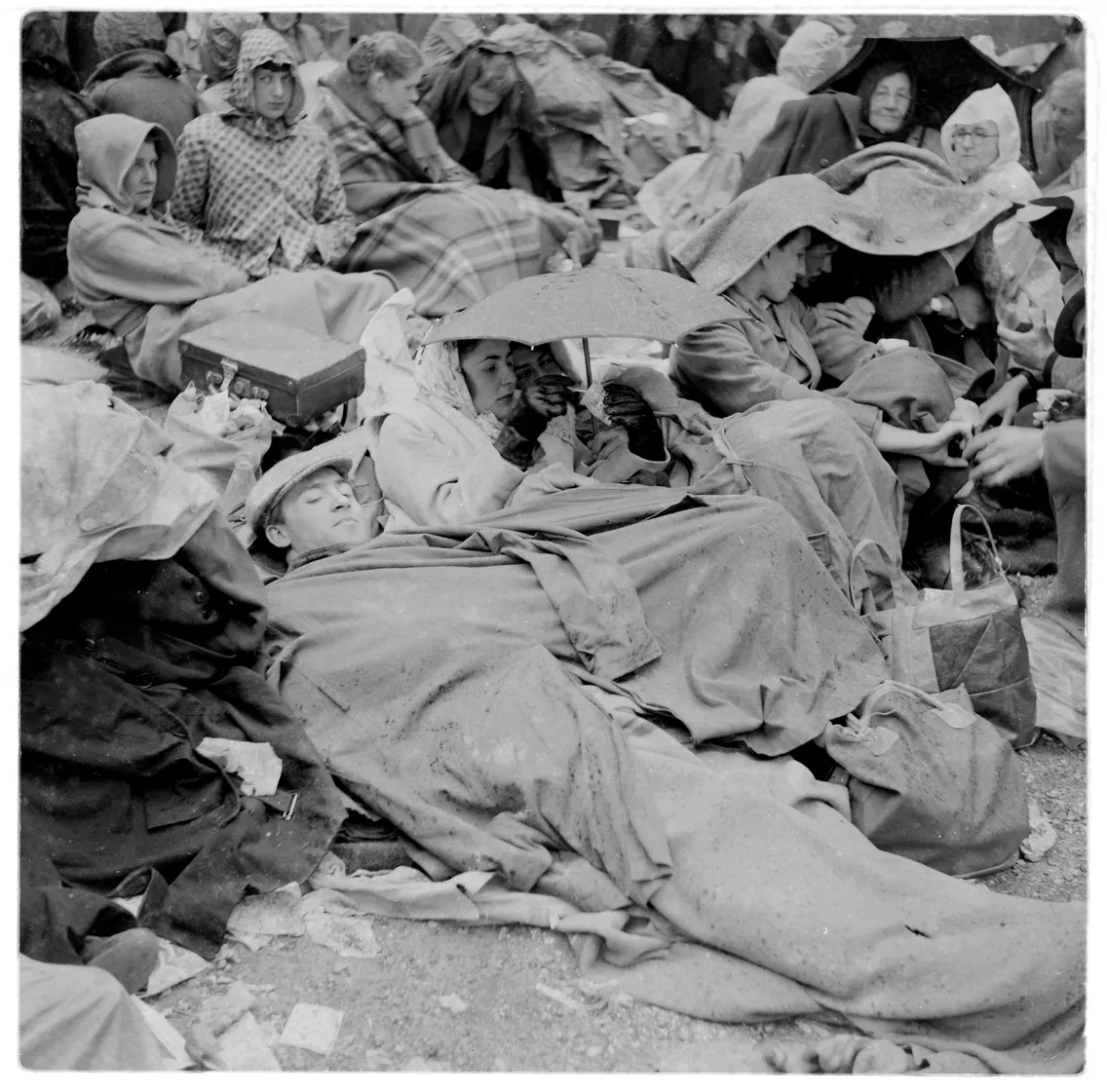17 August 2022 — By Mathilde Renauld
Of gunpowder, vinegar & photo negatives: Conservation & care
The museum has thousands of photo negatives in its collection, dating from the 1880s onwards, and taking care of them is a big task.
Why the blue staining in photo negatives had us worried
During a routine check on photographs for a display at London Museum, we found something was amiss with the negative “IN38139”. Titled “Waiting for the Coronation Procession” by Bob Collins, it was a great shot of crowds sleeping on the streets to get a good viewing spot for Queen Elizabeth II’s Coronation in 1953.
But what should have been a black-and-white negative, showed some blue staining – much to our dismay! Going through several neighbouring boxes showed similar staining on a number of other negatives. And, thus, the museum’s conservation team launched a project to assess the storage of our collection of over 4,300 negatives.
Spanning more than a hundred years of visual culture and testimony since the 1880s, our negatives are the base from which a photograph can be printed for a display or exhibition.
But what is this staining that has us worried?
The negative-positive of things
You may have encountered negatives in your family collections, or you may have developed photographs from negatives yourself. Transparent images freezing memories in time, they can be appreciated when seen against the light. So, why are these called negatives?

The image is initially captured on the negative (left) and then a positive image of that taken, which we refer to as a photograph.
There is a bit of chemistry involved in capturing images with film cameras: photographic film is coated in a substance called the emulsion. In this are silver salts that darken when hit by light. This darkening leads to the creation of an image in which tones are reversed, with brightest areas appearing darkest – hence, the term ‘negatives’.
To get a final image, light is passed through a transparent negative to create a ‘positive’ image on photographic paper.

How light travels through a lens to hit the photographic film in the camera.
These negatives are the base image for all photography and film from the 1850s to the digital era. Early negatives were made on thin paper, then glass, until the invention of plastics enabled a flexible negative film.
Produced by Eastman Kodak from 1889, the practical and portable cellulose-nitrate film revolutionised photography. However, cellulose nitrate is combustible, leading to rapid and explosive fires, which release toxic fumes. In fact, in other industries it is known as “flash paper”, a replacement for gunpowder! Many early film collections worldwide were lost because of this.
So, it was quite a relief when cellulose acetate films – marketed as “safety” film – replaced cellulose nitrate from the 1920s. Yet, nitrate film wasn’t discontinued until the early 1950s, so there was a period of overlap, until polyester started to replace cellulose acetate altogether from 1955. Photography has now vastly shifted to digital since the 1990s, where the main challenge is not keeping negatives safe, but of having enough storage memory in our devices!
At the museum – with thousands of negatives being important keepers of London’s history – careful preservation of these cellulose nitrate and acetate films is our priority. In fact, if you have negatives at home from before the 1960s, chances are they are cellulose acetate and need to be looked after properly too.
It could be blue, it could be yellow: Types of negatives degradation
Cellulose negatives gradually degrade due to their inherent chemical instability. Chemical reactions lead to the material’s disintegration, and once begun, it’s a continuous process. This degradation is often worsened by environmental factors, manufacturing processes, and the film’s own deterioration by-products which include acids. While this is irreversible and cannot be stopped, it can be slowed down when noticed. This is why it’s important to prioritise action – from improved storage to digitisation.
Each plastic has key deterioration stages.
Cellulose nitrate turns yellow to amber due to oxidation, and as degradation progresses, it becomes sticky and releases acids and flammable gases, resulting in complete decomposition, as it liquefies and ultimately dries into a dust.
Cellulose acetate becomes acidic, brittle and tends to shrink. It releases acetic acid (the concentrated version of your kitchen vinegar), so this reaction chain is known as "Vinegar Syndrome". This progresses until separation or loss of the image layer, and dyes may re-activate (our blue staining!).
Conserving photographic heritage for future generations
At the museum, to help plan for long-term preservation, we have to understand the stage of degradation of the collection. One way to do this is to use acid detectors – as cellulose film degradation produces acids, the higher the acid presence, the more advanced is the degradation. Conservators can use ‘indicator paper’, which changes colour to give a visual indication of acid vapours. We place these in boxes containing cellulose negatives, and retrieve them a few days later, to create a record and map out boxes affected by higher acidic contents.
Regular collection audits and surveys also represent an opportunity to monitor and log the condition of negatives. This allows us to take informed decisions and actions. For example, a low level of deterioration may lead to segregating degraded collections from healthy ones, while a fair amount of mildly deteriorated negatives may lead to colder storage facilities. Finally, a large amount of severely degraded negatives would trigger an urgent need for digitisation to save the images before too late.

The indicator strips are kept with the negatives for a couple of days to see if the colour changes.
Prevention! (Since there is no cure)
Several environmental factors are known to impact the rate of degradation of such cellulose-base negatives. Managing these is key to slowing down degradation, both in a museum setting and at home.
- A drier environment is recommended to ensure maximum life expectancy of cellulose-based films. Museums control the Relative Humidity (RH) in storage – which is measured as a percentage of moisture saturation in the air – and maintain it in drier ranges.
- Heat accelerates degradation so it is best to store negatives in a cool place. Severely degraded collections in museums and archives can even be frozen for long-term storage to halt deterioration.
- Pollutants (including those released by negatives) speed-up chemical changes or may trigger new ones. This is true for all collections, but especially problematic for negatives.
Armed with this knowledge, it becomes easier to care for negatives, by ensuring collections are stored in drier, cooler and clean environments. While collections and storage scales will differ vastly between a museum’s storage and your home collection, the principles remain identical.
How to care for photo negatives at home?
This means keeping your negatives away from heat sources such as boilers and radiators, and not in rooms which have humidity issues such as leaky garages or damp cellars. Choosing archival-quality boxes is also crucial as these will not release acids over time. A box that is not airtight also mitigates the accumulation of degradation by-products.
Try to handle your negatives as little as possible, and consider looking into digitisation. As with any photographic material, never touch the surface, and wear surgical gloves if possible to prevent fingerprint damage and for your own safety too.
The museum cares for its collections with a lot of passive work and prioritisation due to time requirements. For many modern materials such as film negatives, understanding our collections better is the first step towards adapting our preservation approach. Gathering data and informing ourselves of the issues will enable us to implement better solutions to ensure the images we hold can live on for as long as possible.
Mathilde Renauld is Conservator (Paper) with the Conservation and Collections Care team at London Museum.

















